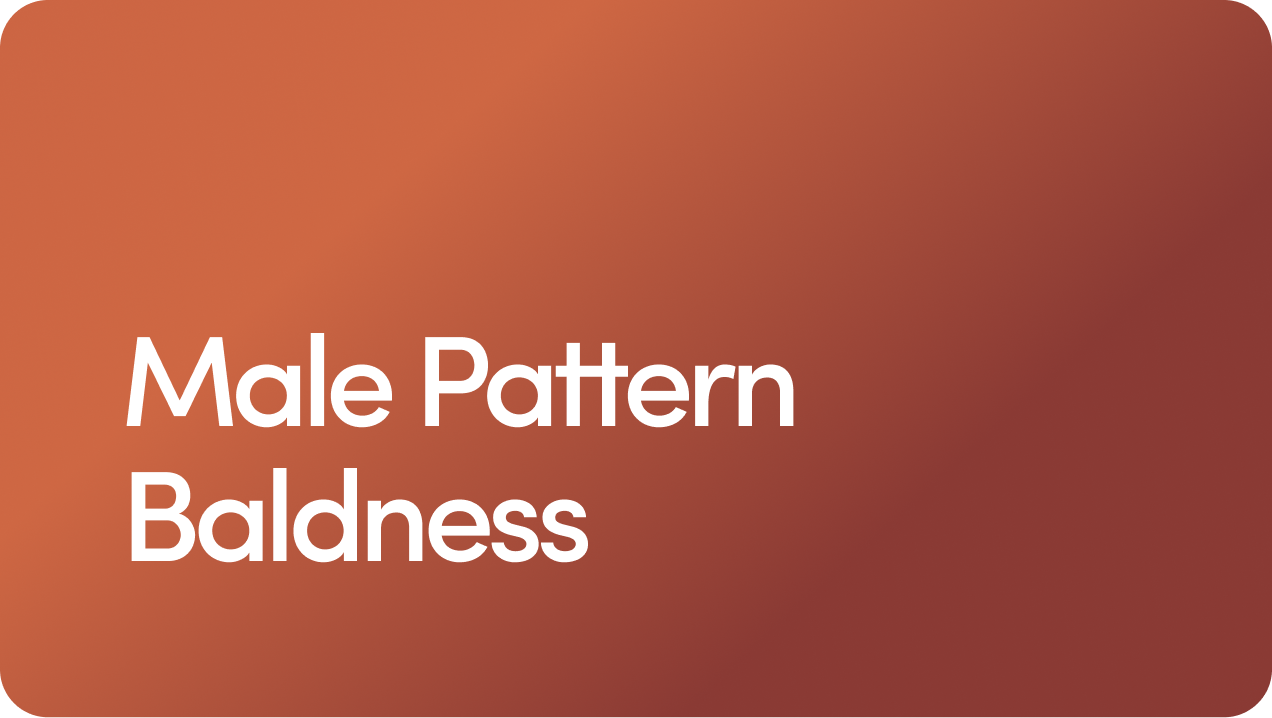Content
FDA approved for more than 25 years
Should Men Use Conditioner? (Spoiler: Yes, and Here’s Why)

Conditioner isn’t just for people starring in shampoo commercials. It’s for every guy who wants hair that looks good, feels healthy, and doesn’t resemble straw after a cold, dry winter or weekend beach trip.
Should men use conditioner? The answer is a resounding yes. Everybody’s hair care routine should include a conditioner, no matter your gender or the length of your hair.
Not sure where to start? No sweat. We’ll cover everything you need to know, including how often you should condition your hair as a male, the benefits of conditioner, and how to use it properly.
Content
Should Men Use Conditioner?
Are guys supposed to use conditioner? Absolutely. Unless you like dry, brittle, and breakage-prone hair, you need conditioner in your grooming routine.
Here’s why: Shampoo’s main job is to clean your scalp and hair, removing dirt, oils, and leftover styling products. But that squeaky-clean feeling? It often comes at a price — stripping away the natural oils your hair needs to stay strong and flexible.
This is where conditioner comes in.
Benefits of Using Conditioner
Conditioner benefits your hair by:
Replenishing moisture and nutrients
Strengthening hair against damage
Sealing and smoothing the hair cuticle
Helping detangle knots
Making hair easier to style and manage
Keeping hair soft and shiny
In other words, using conditioner isn’t a luxury — it’s basic maintenance, like rotating your tires or getting enough sleep.
So, how often should you condition your hair as a male? According to the American Academy of Dermatologists, you should condition your hair every time you shampoo. Yes, even if you have oily hair.
Here’s a cheat sheet for how often to condition hair:
Normal hair (not particularly dry or greasy). Condition every time you shampoo.
Dry or damaged hair. Condition after every time you wash, plus consider a deep-conditioning treatment or hair mask once or twice a week.
Oily hair. You can still condition your hair every time you lather up. But stick to lightweight conditioners and apply mainly to the mid-lengths and ends of your hair — not your scalp.
If you have dry hair, you might want to try a leave-in conditioner. Otherwise, rinse-out conditioners work perfectly fine.
If you’re washing your hair daily (which most guys don’t actually need to do unless they’re super active and sweat a lot), you can still use a small amount of conditioner each time to maintain moisture balance.
Over-conditioning is rare, but using too much product — or applying it directly to the scalp if you’re prone to oiliness — can cause product buildup, which can leave your hair looking flat or greasy. A light touch goes a long way.
If you’ve Googled “how to condition hair male,” you’re not alone. Alright, let’s learn how to condition your hair without making it overly complicated.
Step 1: Shampoo your hair and rinse it thoroughly.
Step 2: After shampooing, squeeze out excess water from your hair. You want your hair damp, not soaking wet.
Step 3: Dispense a small amount of conditioner (about a nickel-sized amount for short hair, more if you have longer hair).
Step 4: Rub the conditioner between your palms, then apply it starting from the mid-shaft and down to the ends of your hair. These are the parts that need the most moisture.
Step 5: Avoid massaging conditioner directly into your scalp, especially if you have thinning or oily hair. (Your scalp’s natural oils have that covered.)
Step 6: Let the conditioner sit for two to three minutes to do its thing. Think of it as marinating your hair in goodness.
Step 7: Rinse thoroughly. No need to leave any residue behind — conditioner won’t work better if you leave it on longer than needed. Follow up with a quick comb-through if you want extra smoothness and fewer tangles.
If you have dry hair, you might want to try a deep-conditioning hair mask once or twice a week. Use it the same way you use regular conditioner, but keep it in your hair for 10 or so minutes before washing it out thoroughly.
Skipping conditioner is kind of like skipping body lotion. It’s not the end of the world, but your hair (and appearance) might pay the price over time.
The American Academy of Dermatology notes that skipping conditioner is one of the top hair care habits that can lead to damaged hair.
Without conditioner, you risk:
Dry, brittle strands
Frizz and flyaways
Damage and split ends
Hair that’s harder to style and manage
Increased chances of breakage (especially if you use heat tools or spend time in the sun)
And no, shampoos can’t do the same job as conditioners — even ones with nourishing natural ingredients, like aloe vera or argan oil.
Though conditioner is essential for healthy hair, it doesn’t improve hair growth. Its job is to keep your hair strands healthy — not to stimulate your hair to grow in the first place.
With that said, some hair care products — like our thickening conditioner — contain ingredients that promote hair growth while keeping hair moisturized and strong.
If hair loss is a concern for you, you can try clinically backed hair loss treatments like:
Finasteride (generic Propecia®). Approved by the U.S. Food and Drug Administration (FDA), oral finasteride is a prescription treatment for male pattern hair loss.
Minoxidil (generic Rogaine®). Another FDA-approved medication, minoxidil stimulates hair follicles and improves blood flow in the scalp. You can buy minoxidil topical solution and minoxidil foam online without a prescription.
A combo treatment. You can use finasteride and minoxidil at the same time to improve hair growth. We offer topical finasteride & minoxidil spray and chewable minoxidil-finasteride hybrids.
You might also want to check out our blog posts on natural hair growth tips and ways to get thicker hair.
What Type of Conditioner Do Men Use?
Not all conditioners are created equal. The best hair conditioner is one that suits your hair type and texture.
Opt for:
Lightweight conditioner if you have oily or fine hair
Moisturizing conditioner if you have dry, damaged, or curly hair
Detangling conditioner with silicones or natural oils for longer, textured, or curly hair
Leave-in conditioner if your hair needs extra hydration
Strengthening conditioner if you’re trying to prevent thinning or breakage
You might also be curious about whether a two-in-one shampoo is good enough. For guys with very short, low-maintenance hair, a quality two-in-one product might work. Generally, though, most people need separate shampoos and conditioners.
Luckily, you don’t have to search too far. We have a range of men’s hair products to suit all types of hair.
Let’s settle it once and for all: Yes, guys should absolutely use conditioner, even those who don’t have long hair. It’s an essential component for hair health.
Keep this in mind:
Conditioner keeps dryness at bay. It also smooths frizzy hair, protects against damage, and makes your hair look shiny and healthy.
Condition every time you shampoo. Focus on applying conditioner to the lengths and tips of your hair — the parts of the hair shaft that generally need more hydration.
Use the right conditioner for your hair type. Oily or fine hair might benefit from lightweight conditioner, while dry hair could use a more nourishing formula.
A good-quality conditioner is the easiest upgrade you can make to your hair routine — no complicated steps and no salon appointment required.
But if you’re dealing with thinning hair or other signs of hair loss, consider speaking with a healthcare professional about hair loss treatment options. Medications like finasteride and minoxidil can go a long way in helping you grow thicker, healthier hair.
Take the free hair quiz to start exploring your options.
3 Sources
- American Academy of Dermatology Association (AAD). (n.d.). 10 hair care habits that can damage your hair. https://www.aad.org/public/everyday-care/hair-scalp-care/hair/habits-that-damage-hair
- American Academy of Dermatology Association (AAD). (n.d.). Tips for healthy hair. https://www.aad.org/public/everyday-care/hair-scalp-care/hair/healthy-hair-tips
- Ho CH, et al. (2024). Androgenetic alopecia. https://www.ncbi.nlm.nih.gov/books/NBK430924/
Editorial Standards
Hims & Hers has strict sourcing guidelines to ensure our content is accurate and current. We rely on peer-reviewed studies, academic research institutions, and medical associations. We strive to use primary sources and refrain from using tertiary references. See a mistake? Let us know at [email protected]!
This article is for informational purposes only and does not constitute medical advice. The information contained herein is not a substitute for and should never be relied upon for professional medical advice. Always talk to your doctor about the risks and benefits of any treatment. Learn more about our editorial standards here.
Knox Beasley, MD
Education
Bachelor of Science, Life Sciences. United States Military Academy.
Doctor of Medicine. Tulane University School of Medicine
Training
Dermatology Residency. San Antonio Uniformed Services Health Education Consortium
Certifications
Board Certified. American Board of Dermatology
Medical Licenses
Dr. Beasley is licensed in all 50 states
Affiliations & Memberships
Fellow, American Academy of Dermatology
Specialties & Areas of Focus
Hair Loss, Dermatology
Years of Experience
10 years of clinical practice as a Dermatologist
Previous Work Experience
Medical Director - YouHealth Medical Groups, 2025–
Private practice, 2024–
Chief of Dermatology - , 2015–2019
Publications
Wilson, L. M., Beasley, K. J., Sorrells, T. C., & Johnson, V. V. (2017). Congenital neurocristic cutaneous hamartoma with poliosis: A case report. Journal of cutaneous pathology, 44(11), 974–977.
Banta, J., Beasley, K., Kobayashi, T., & Rohena, L. (2016). Encephalocraniocutaneous lipomatosis (Haberland syndrome): A mild case with bilateral cutaneous and ocular involvement. JAAD case reports, 2(2), 150–152.
Patterson, A. T., Beasley, K. J., & Kobayashi, T. T. (2016). Fibroelastolytic papulosis: histopathologic confirmation of disease spectrum variants in a single case. Journal of cutaneous pathology, 43(2), 142–147.
Beasley, K., Panach, K., & Dominguez, A. R. (2016). Disseminated Candida tropicalis presenting with Ecthyma-Gangrenosum-like Lesions. Dermatology online journal, 22(1), 13030/qt7vg4n68j.
Kimes, K., Beasley, K., & Dalton, S. R. (2015). Eruptive milia and comedones during treatment with dovitinib. Dermatology online journal, 21(9), 13030/qt8kw141mb.
Miladi, A., Thomas, B. C., Beasley, K., & Meyerle, J. (2015). Angioimmunoblastic t-cell lymphoma presenting as purpura fulminans. Cutis, 95(2), 113–115.
Beasley K, Dai JM, Brown P, Lenz B, Hivnor CM. (2013). Ablative Fractional Versus Nonablative Fractional Lasers – Where Are We and How Do We Compare Differing Products?. Curr Dermatol Rep, 2, 135–143.
Siami P, Beasley K, Woolen S, Zahn J. (2012). A retrospective study evaluating the efficacy and tolerability of intra-abdominal once-yearly histrelin acetate subcutaneous implant in patients with advanced prostate cancer. UroToday Int J, June 5(3), art 26.
Siami P, Beasley K. (2012). Dutasteride with As-Needed Tamsulosin in Men at Risk of Benign Prostate Hypertrophy Progression. UroToday Int J, Feb 5(1), art 93. https://www.urotoday.com/volume-5-2012/vol-5-issue-1/48691-dutasteride-with-as-needed-tamsulosin-in-men-at-risk-of-benign-prostatic-hypertrophy-progression.html
Why I Practice Medicine
Dr. Beasley began doing telemedicine while serving in the U.S. Army, providing dermatologic care for soldiers stationed around the world. This experience sparked his passion for telemedicine and inspired his commitment to expanding access to healthcare for patients across the United States.
Hobbies & Interests
In his free time, Dr. Beasley enjoys cooking, reading, and trips to the beach with his wife and two kids (with sunscreen of course).
Related Articles
Related Conditions
 Hair Loss
Hair Loss
 Male Pattern Baldness
Male Pattern Baldness
 Dandruff
Dandruff
 Scarring Alopecia
Scarring Alopecia
 Seborrheic Dermatitis
Seborrheic Dermatitis
